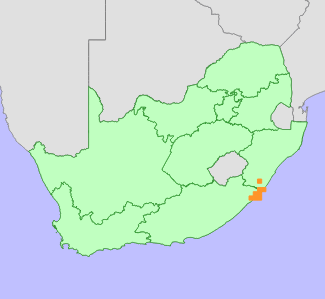|
Scientific Name | Leucospermum innovans Rourke |
Higher Classification | Dicotyledons |
Family | PROTEACEAE |
Common Names | Pondoland Pincushion (e) |
National Status |
Status and Criteria | Endangered A4c; B1ab(ii,iii,v)+2ab(ii,iii,v) |
Assessment Date | 2019/09/11 |
Assessor(s) | A.G. Rebelo, H. Mtshali & L. von Staden |
Justification | Leucospermum innovans is endemic to the Pondoland region of South Africa and has an extent of occurrence (EOO) of 2680-2920 km² and an area of occupancy (AOO) of 104 km². Expanding agriculture and afforestation has reduced its range. The remaining subpopulations are severely fragmented and are threatened by ongoing decline and degradation of habitat due to expanding human settlement, crop cultivation, alien invasive encroachment and too frequent fires. The population will experience a decline of 50-60% over a three generation period including two generations in the past (100-200 years) and one generation into the future (50 to 100 years). It therefore qualifies as Endangered under criterion A and B. |
Distribution |
Endemism | South African endemic |
Provincial distribution | Eastern Cape, KwaZulu-Natal |
Range | An endemic to the Eastern Cape and KwaZulu-Natal Provinces of South Africa, it occurs in the Pondoland region from the Umtamvuna River to Ntsubane. |
Habitat and Ecology |
Major system | Terrestrial |
Major habitats | Pondoland-Ugu Sandstone Coastal Sourveld |
Description | It grows most prominently in Pondoland-Natal Sandstone Coastal Sourveld in shallow soils, 0-700 m. It is a long-lived species (generation length 50-100 years), and survives fires by resprouting from underground boles or rootstocks. Seeds are released after ripening, and dispersed by ants to their underground nests, where they are protected from predation and fire. It is pollinated by birds. |
Threats |
| At least 45% of this species' habitat has already been transformed, mainly due to agriculture and afforestation. Known subpopulations all occur on isolated remnants of natural vegetation where they are threatened by ongoing habitat loss and degradation, rural and coastal housing expansion, overgrazing, too frequent fires, and competition from alien invasive plants. |
Population |
This species occurs in isolated patches of a few plants. Only the subpopulation near Kilroe Beach is quite extensive, thus over 50% of the population occurs as small isolated subpopulations and is considered severely fragmented. There has been a 45% decline to the population in the past two generations (100-200 years) as inferred from loss of its habitat. A further 5-10% decline to the population is predicted over the next 50 to 100 years due to ongoing habitat degradation and coastal rural development.
|
Population trend | Decreasing |
Conservation |
| It is protected in the Mtamvuna Nature Reserve.
Not conserved. A major subpopulation occurs just outside the Mkambati Game Reserve.(Rebelo 2006). |
Assessment History |
Taxon assessed |
Status and Criteria |
Citation/Red List version | | Leucospermum innovans Rourke | EN B1ab(ii,iii,v)+2ab(ii,iii,v) | Raimondo et al. (2009) | | Leucospermum innovans Rourke | VU | Scott-Shaw (1999) | | Leucospermum innovans Rourke | Vulnerable | Hilton-Taylor (1996) | |
Bibliography |
Boon, R. 2010. Pooley's Trees of eastern South Africa. Flora and Fauna Publications Trust, Durban.
Hilton-Taylor, C. 1996. Red data list of southern African plants. Strelitzia 4. South African National Botanical Institute, Pretoria.
Raimondo, D., von Staden, L., Foden, W., Victor, J.E., Helme, N.A., Turner, R.C., Kamundi, D.A. and Manyama, P.A. 2009. Red List of South African Plants. Strelitzia 25. South African National Biodiversity Institute, Pretoria.
Rebelo, T. 2001. Sasol Proteas: A field guide to the proteas of southern Africa. (2nd ed.). Fernwood Press, Vlaeberg, Cape Town.
Scott-Shaw, C.R. 1999. Rare and threatened plants of KwaZulu-Natal and neighbouring regions. KwaZulu-Natal Nature Conservation Service, Pietermaritzburg.
|
Citation |
| Rebelo, A.G., Mtshali, H. & von Staden, L. 2019. Leucospermum innovans Rourke. National Assessment: Red List of South African Plants version . Accessed on 2025/06/27 |
 Comment on this assessment
Comment on this assessment

